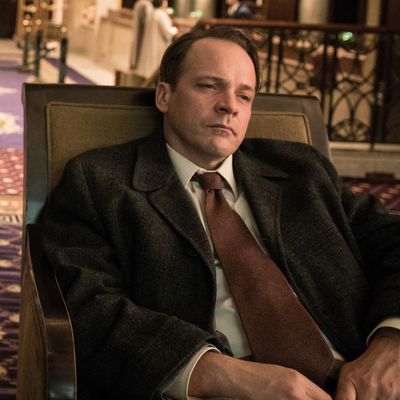
No true-crime mystery is complete these days without a comprehensive timeline of events, and Errol Morris gives us a doozy for the second Wormwood episode. With patience and determination, he walks us through the major happenings that transpired in the nine days between Frank Olson’s unwitting LSD trip at Deep Creek Lake and his fatal plummet in New York City. What happened in that timeframe that could have either compelled him to suicide, as the official CIA line goes, or convinced his superiors that he needed to be disposed of?
On that front, there are no clear answers yet. We learn that Olson came home acting not like himself, suddenly clamming up around his wife, Alice (Molly Parker). He went to see a movie, Irving Pichel’s 1953 biopic Martin Luther, a choice that carries a good deal of significance — at least in the eyes of his son Eric, who frames the film as a wake-up call to his father, possibly shaking him into quitting whatever CIA misdeeds were happening at Camp Detrick and nailing his own version of the theses to the door. Olson was also directed to start meeting with a CIA-approved New York “physician” named Harold Abramson (Bob Balaban), a man who, we’re told, was chiefly an allergist. Hardly the first referral you’d expect for a man suffering from paranoia, erratic behavior, and nervous breakdowns.
There’s still no smoking gun, but Abramson’s nutty diagnostics tests and secret communiques with the MKUltra folks are unnerving, mostly because these scenes turn Wormwood into a paranoid thriller where we can’t even trust the hero’s doctor to confidentiality. Indeed, paranoia is littered all over the “evidence” that the Olson family extracts from the government in 1975, evidence that’s peppered with inconsistent official testimonies and unresolved holes in the timeline of Frank’s death. It shouldn’t be too surprising that the CIA wouldn’t declassify what it was doing, just the bare minimum they could get away with, but the revelations do serve to highlight just how deep you need to go into an official account before you can extract anything even remotely resembling truth.
“Chapter 2” adds more involved reenactments this time around, which helps ground the story more firmly in the reality it’s building. Sarsgaard is a standout as Frank Olson, delivering a moving performance of a man being tortured by his own mind and likely knows he’s doomed. Errol Morris and cinematographer Igor Martinovic seem determined not to shoot this part of Wormwood like a traditional drama, showing us only fragments of scenes, framed off-kilter, and edited like a mind-control nightmare. It’s a cruel kind of irony that all of this was perhaps done to keep Wormwood anchored to the realm of documentary, only to get disqualified for Oscar consideration anyway because too much of it was staged. (Though getting snubbed by the Oscars is nothing new for Morris, who first introduced the concept of reenactments to the genre with The Thin Blue Line and received a disqualification for his efforts.)
The sheer scope of time here is also a useful window into why Eric Olson, not to mention the other people digging for answers, might have been inclined to give up on their crusade. Twenty-two years is a long time to wait for anything, let alone a false resolution to your father’s highly suspicious death. “You are never gonna know what happened in that room,” a refrain of resignation that Morris can’t resist remixing, isn’t a threat but a sad recitation of what the Olsons, for so long, simply had to regard as the truth. They weren’t gonna know what happened in that room, and yet Eric continued to devote his life to trying to find out. If Morris can’t deliver by the end of Wormwood, well, it might just be another lump of disappointment to throw on the investigation’s pile.
Burning Questions
• How does Dr. Abramson fit into this complex web? Was he trying to gain information from Olson, or merely subdue him for the CIA’s benefit?
• How much of Olson’s crisis of conscience in those nine days can be chalked up to the drugs, and how much was he experiencing a legitimate “Martin Luther” moment?

